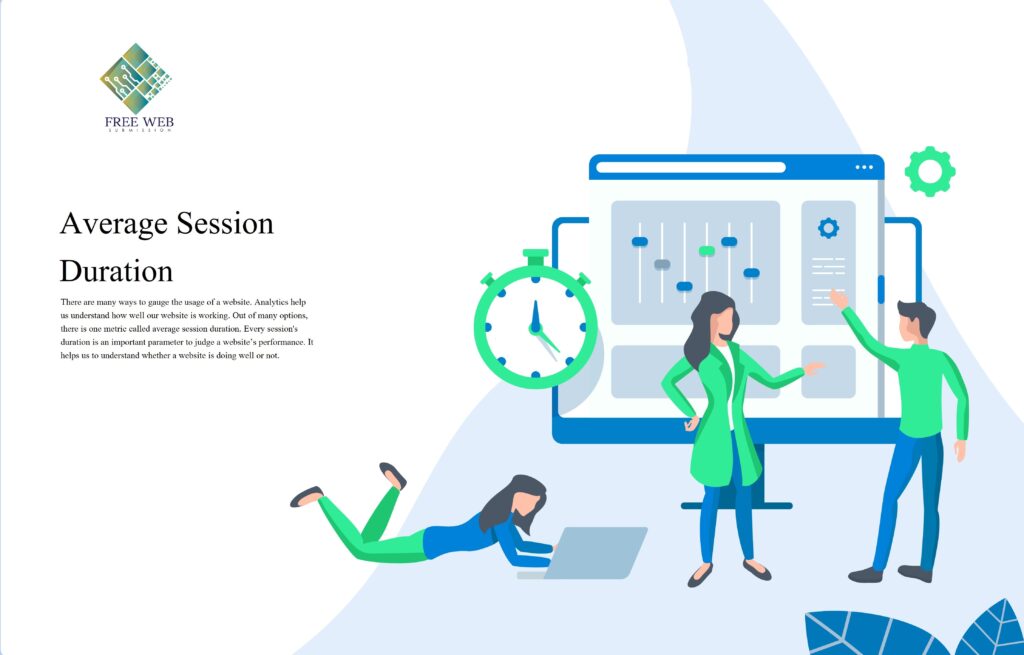
There are many ways to gauge the usage of a website. Analytics help us understand how well our website is working. Out of many options, there is one metric called average session duration. Every session’s duration is an important parameter to judge a website’s performance. It helps us to understand whether a website is doing well or not.
Average session duration gives us an average amount of time that users spend on your website. This can help the web developers understand and take action accordingly. A detailed analysis of the average session duration can help us understand the user and optimize our websites as per their needs. This helps us increase the conversion rate, user experience, engagement, etc. In this article, we will understand everything about the average session duration.
By definition, average session duration is the average time that a user spends on a website during a single visit. A single visit or session starts when a user arrives at the website and ends when there is an inactivity of 30 minutes.
In order to find the average session duration, find
the total duration of all sessions, say ‘x’
(It is the sum of all the time spent in a specific period.)
and total number of sessions, say ‘y’
(total count of sessions in that specific period)
then,
Average Session Duration = x/y

The average session duration is crucial for many reasons. These are the reasons why a high average session duration is important.
1. User Engagement: A higher average session duration shows that there is a lot of user engagement. This means that people are finding the content enjoyable and satisfactory. The website looks decent enough, and this is a very good sign.
2. Content Quality: This factor determines the actual session duration. If the quality of the content is good, then people will naturally find it helpful or interesting. Therefore, the quality of the content matters a lot and thus affects the average session duration.
3. User Experience: The user experience is the look and feel that the user gets while exploring the web page. It can be the website’s design, animation, the way to navigate, etc. It all depends on the creativity of the designer. If the user experience is pleasant, naturally people would like to spend more time on the website, and therefore the average session duration gets an uplift.
4 Conversion rates: If a website is well developed and the average session duration is high, people will more likely spend their time on the website and therefore easily get convinced to follow a desired action. When someone follows a desired action, we say that the person “converts.” If the frequency of conversion is high, then we say that the conversion rate is increasing.
The average session duration provides insight into user engagement and content quality. Therefore, it becomes an important metric for Google searches. Let us see how:
To create a perfect website, one must understand and learn to effectively use average session duration for SEO. It is important to understand that there are many strategies and aspects that need to be considered. Firstly, you should be well-versed in the factors that affect the average session duration, which we already mentioned. Following are some of the extra points that you should keep in mind, especially for SEO:
After reading this article, you can now comprehend the importance of all the factors and things related to average session duration. We hope that you optimize or build the website of your dreams and achieve greater success.
There are multiple ways in which we can enhance our average session duration. These are the factors that need to be considered when we are building or enhancing our website.

Now we are going to discuss some strategies through which we can enhance the average session duration. The primary focus will be on enhancing the user experience and providing valuable content.

Following are some of the basic templates of every anchor text type in SEO. You can also take help of the examples. :
Google Analytics: Google Analytics is one of the most popular tracking tools, which also includes various other metrics like the average session duration. It prepares detailed reports on user behavior, traffic sources, and engagement metrics. Different app integrations are also available.
Adobe Analytics: This is an analytical tool offered by Adobe. They have advanced segmentation features and in-depth analysis capabilities. It can integrate with Adobe products as well.
Other analytical tools: Other analytical tools include Mixpanel, Matomo, Heap Analytics, Hotjar, etc.
These tools have their own unique features. Using these helps in developing a good, user-friendly website.
In order to get closer to the accurate average session duration, it is important to follow certain practices for the best results.
Every segment has a different way to treat content. By understanding demographic data and behavior patterns, we can segment the users effectively.
Analyze every session duration by different user segments. A tutorial will have a shorter average session duration, whereas a book summary may take longer sessions.
Use other metrics and compare session durations with other tools. This will help you understand your data better.
Make sure that you include the factor of limitations, which is explained above. This will help you gain a better understanding of your website.
When you set benchmarks and a checkpoint, they act as motivation and a target to achieve. There will always be a reason for you to hustle and work harder. They mainly help you identify areas for improvement.
Don’t miss our future updates! Get Subscribed Today!
Free Web Submission Directory © Copyright 2025, All Rights Reserved. Design and Maintained by Beaver Marketing Agency